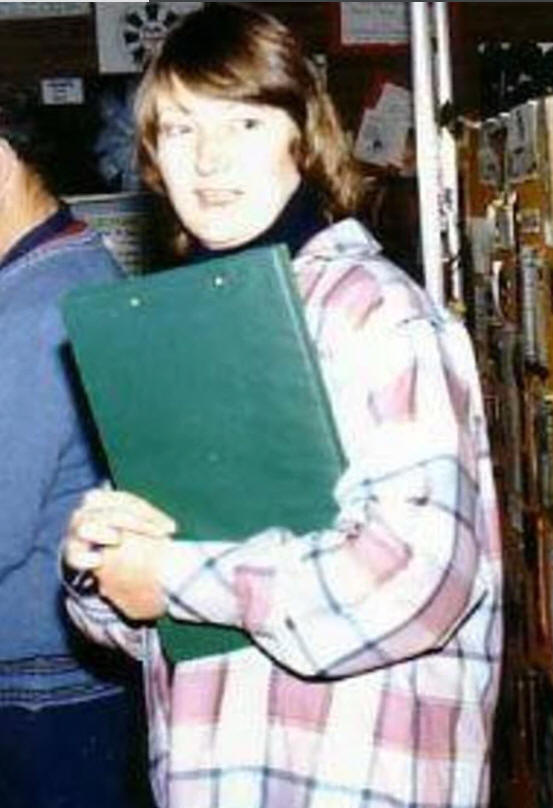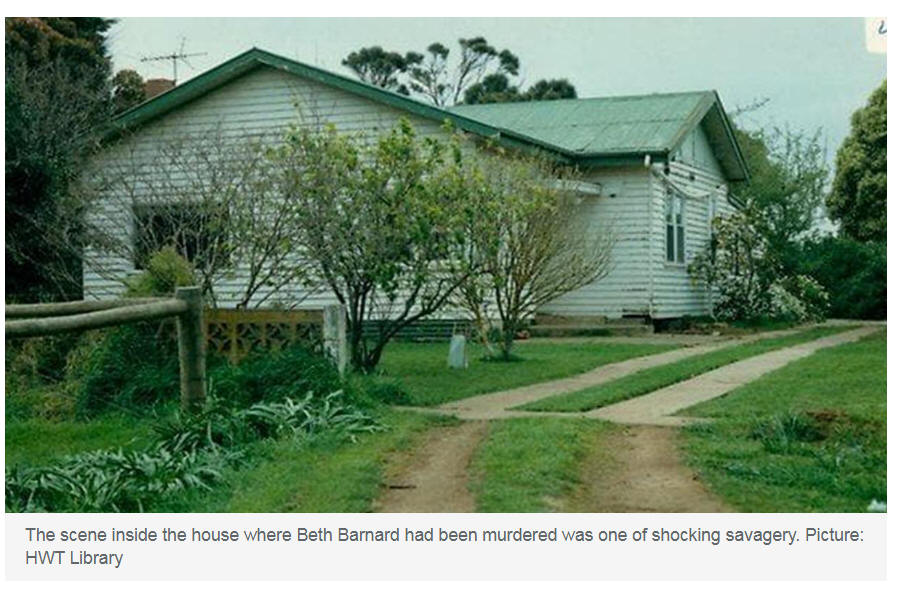His wife, he said, had confronted him about his longstanding affair with Beth Barnard (pictured), a 23-year-old woman who used to work on their property as a farmhand.
As tensions escalated, Fergus told police, Vivienne grabbed a wine glass and attacked him, striking him on the side of the head and on his back.
After seeking treatment at the hospital, the couple returned home around midnight. Vivienne then dropped him to his sister's place in their Land Cruiser, and around 3am phoned a friend to collect their two children. She told them she needed to take her husband to the hospital; a trip that that had occurred hours earlier.
By the time the Phillip Island community woke that morning, Vivienne was nowhere to be found. And Beth Barnard was dead.
The wine glass, the handbag and other curious questions.
Beth Barnard's injuries were some of most gruesome police had encountered.
She lay in her bed, covered by doona that masked the worst of them.
Her throat had been slit, her body stabbed and cut, and there were wounds to her hands and forearms suggesting she had tried to defend herself.
A large letter 'A' had been roughly carved into her chest, which speculation suggests could be an allusion to Nathaniel Hawthorne's 1850 novel The Scarlet Letter, in which an adulterous woman is sentenced to wear a red 'A' as a punishment.
A kitchen knife lay nearby. As did a littering of cigarette butts, later determined to be Claridge and Peter Stuyvesant brand (Beth wasn't known to be a smoker). No distinguishable fingerprints were found.
It was Fergus' brother and brother-in-law who'd discovered Beth's body. They dispatched them to the home that morning amid news of Vivienne's disappearance and with her alleged threat from the night before ringing in his ears.
Later that afternoon, the family's Land Cruiser was found parked at the Phillip Island Bridge. Vivienne's handbag was inside, along with two packets of Claridge cigarettes, a box of matches, a face cloth, and a knife. Fearing the worst, police divers scoured the water for days, but to no avail.
The conclusion reached by authorities was that, after dropping off her husband, Vivienne had murdered Beth, then taken her own life.
Fergus had told police that, before he and his wife entered the hospital after their altercation, she'd threatened that she was "going to get that little bitch".
A 1988 coronial inquest accepted that version of events.
"Although [Vivienne's] body has not been found, I am satisfied that she is dead, and that she leapt from the bridge into the water," Victorian Coroner BJ Maher concluded. "And I further find that the deceased contributed to the cause of death."
Enough questions linger that, in September 2020, Victoria Police confirmed cold case homicide detectives were still looking into Beth's murder.
Among the inconsistencies is the insistence of local woman Glenda Frost that she spoke to Vivienne at 10am on the morning of her disappearance, long after she was purported to have taken her life.
In her years-long investigations into the case, crime writer Vikki Petraitis, the author of The Phillip Island Murder, has spoken to Glenda several times.
In a recent interview with Mamamia's True Crime Conversations podcast, she explained that the pair worked together at the Community House, and that the phone call was regarding a present for a retiring co-worker.
A friend who was with Glenda at that time has corroborated that Glenda spoke to a person she believed to be Vivienne.
"It was Vivienne, Glenda was absolutely certain of that. It was about a subject that nobody else would have known about. And Glenda is absolutely certain that it happened. But the coroner didn't take that into account in his findings."
Vikki, who worked with Casefile on a podcast about the case, points to other curiosities.
For one, no broken wine glass was recorded when police searched the Camerons' home.
Also, the couple who collected the unsupervised Cameron children in the middle of the night claim they saw Vivienne's handbag there — the same handbag later found in the abandoned Land Cruiser.
If that's accurate, it would suggest that sometime in between killing Beth and taking her own life, Vivienne drove home to collect it — something that muddies the official timeline.
For Vikki, the key question is whether, if she were alive today, Vivienne would be convicted of murder.
There is little evidence connecting the mother with the murder scene, and no traces of Beth's blood in the Land Cruiser she apparently drove afterwards, despite the frenzied, messy nature of the killing.
"If she stepped forward and said, 'I didn't do it', I don't think they would be able to prove otherwise," Vikki said. "I don't think there's enough there.
"For me, it's always been about a sense of justice. And if she didn't do it, then that means that Beth's murder has [gone unpunished].
"I suppose until we get an answer, we're just left to ask a lot of questions."
Vikki Petraitis' Casefile podcast, The Vanishing of Vivienne Cameron, is available on Spotify.
Under Investigation: The love triangle murder mystery that haunts an Aussie island
But in the early hours of September 23, 1986, the island was the scene of one of Victoria's most horrific crimes when 23-year-old Beth Barnard was viciously murdered.
The victim was the young mistress of Fergus Cameron, one of the island's most prominent and wealthy family members, and the prime suspect was his wife, Vivienne.
But Vivienne Cameron has never been seen since the night of the attack.
On Under investigation, a panel of experts looks at the evidence, the police investigation and re-examines what happened that terrible night on Phillip Island.
The Young Mistress
To outsiders, the small and tight-knit community of Phillip Island might appear to be closed and even secretive.
One of those outsiders was Vivienne Candy, who married Fergus Cameron and moved with him to the island in the late 1970s.
While Vivienne struggled to fit in, Fergus became acquainted with a bubbly 21-year-old, Beth Barnard, who worked at Phillip Island's Penguin Parade, where Fergus was also a volunteer.
Four months later, Fergus employed Beth as a farmhand on the family property and by May 1985 their affair had begun.
Vivienne, whose father had left her mother for a younger lover, repeatedly suggested marriage counselling to Fergus as she grew suspicious he was involved in an affair.
The Bloody Showdown
On Monday, September 22, 1986, at around 9pm, Fergus arrived home late after being with Beth.
According to his police statement, Fergus said Vivienne became verbally and physically abusive. She struck him with a wine glass, cutting his ear and back.
'At that point in time, she had formed some sort of intent ... so she was up to something.'
But some questioned Fergus' version of events, given Vivienne's account of the night has never been heard.
For example, medical staff at the hospital where the couple sought treatment that night reported they appeared very much together.
But when Fergus' sister Marnie arrived at their home, she said she saw signs of a struggle.
Inside was a pile of bloodied clothes and towels and blood-stained tissues in the bathroom.
Where Is Vivienne?
Fergus Cameron told police he and Vivienne had a violent showdown, that their marriage was over, and she would give him custody of her beloved sons.
At 1am, she drove him to stay with his sister Marnie. That was the last time anyone saw her.
Vivienne then phoned a friend at 3am and told her she was at the hospital. But according to police, it was an alibi for murder.
Gary Jubelin, a 30-year veteran of the NSW Police Force and one of Australia's most celebrated homicide detectives, agreed the call was suspicious.
"At that point in time, she had formed some sort of intent at 3am, so she was up to something."
Could A Woman Be the Killer?
In the early hours of Tuesday, September 23, 1986, Beth was viciously attacked.
A bloodied knife was left by Beth's side and the killer covered her body with a doona.
In a terrible revelation for those who discovered the murder scene, the letter "A" had been carved into Beth's torso. Investigators presumed the "A" stood for adulteress — a reference to the 1850s novel The Scarlet Letter by Nathaniel Hawthorne, studied in Australian schools at the time.
'The brutality of it shows that emotionality behind it, which also suggests that they are known to the victim.'
Kathryn Whiteley, criminologist and world-renowned expert on women who kill, found it hard to believe Beth's killer was a female.
"I'm seeing a very masculine, male killing as opposed to a female killing," she told the panel.
But forensic psychologist Dr Sarah Yule believes the frenzied attack on Beth suggests a powerful rage and even revenge.
"The brutality of it shows that emotionality behind it, which also suggests that they are known to the victim."
Did Vivienne Fake Her Death?
The morning after Beth's murder, the Cameron family noticed the family's Land Cruiser was missing. Vivienne had also not been heard from.
Fergus asked his brother and brother-in-law to drive to Beth's house and check on her.
It was there that they made the shocking discovery of her mutilated body.
But instead of calling Fergus, they drove to the police station where they reported Beth's death. At this stage it seemed no-one, including her family, were searching for Vivienne.
At 4pm, the Land Cruiser was finally found near the San Remo Bridge, around 13 hours after the suspected time of Beth's murder.
Police believe the location of the car strongly suggests that Vivienne had jumped from the bridge, but despite an extensive search over several days, no trace of her was ever found.
The Final Verdict
A love triangle in the small community of Victoria's Phillip Island ends in a brutal murder.
Beth Barnard is dead and her presumed killer, Vivienne Cameron, has never been seen again.
But could Vivienne have committed the perfect crime and staged her death?
Valentine Smith, former senior Victoria Police detective and now CEO of MiPerNet Missing Persons Network, believes it's unlikely that Vivienne faked her death.
"She did a very bad job, because if it's a disappearance that she's trying to stage or a pseudo-death, she's failed."
Beth suffered horrifically and Vivienne, police believe, is the only person known to have a clear motive to commit the crime.
Her guilt is still to be tested.
But Stephanie Williams and Lauren McCarthy, investigators in the US who have looked at the case, told the panel that had Vivienne faced trial she might not have been convicted.
"I think the investigation still has many stones left unturned. I just think people have to explore those," Lauren said.
For the people of Phillip Island, this was a devastating crime that ended in the loss of two women's lives that continues to haunt them.

